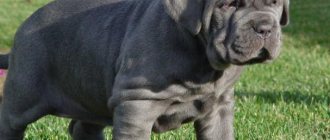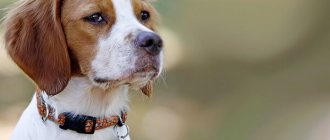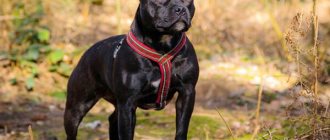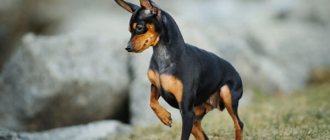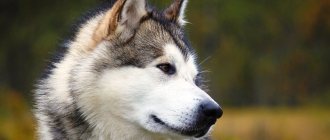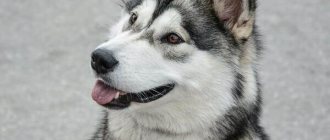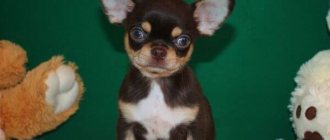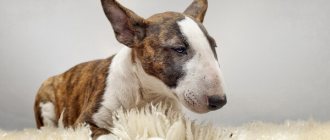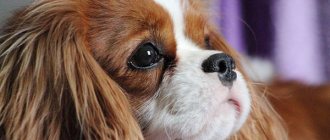Mastiffs are the name of a large group of dog breeds that are similar in certain characteristics.
These include Tibetan, English, Spanish, Major, Brazilian, American, Japanese and other varieties.
This also includes the Neapolitan Mastino, also known as the Neapolitan Mastiff - a large dog with a heavy look.
This large dog with a folded muzzle is one of the most ancient breeds of Italian origin.
Despite its frightening appearance, the dog is friendly, calm and capable of becoming a devoted friend.
The Mastiff is also a good guard, hunter and protector.
Origin story
The origin of the breed occurred more than two thousand years ago. The ancestors of the Neapolitan Mastiff are considered to be ancient fighting dogs - Molossian Danes. They were used to herd livestock and protect homes.
There is an opinion that the first mention of them appeared during the time of Alexander the Great. The Indian king, conquered by him, presented two puppies of this dog as a gift. In addition to India, images of similar large dogs were found at that time in Persia and Nineveh.
Breeders began breeding pure breeds much later. Pietro Scanziani was the first to introduce dogs to international dog shows in 1946. It showed 8 individuals with certain characteristics and traits.
NOTE!
After three years, the breed standard was approved. However, it underwent quite a few changes and the final version was adopted only in 1999.
Interesting facts about the breed:
- These dogs are not at all hasty. Dogs were formerly used to herd livestock such as buffaloes. Calmness and measuredness were required so that the bulls would not be frightened. This is where this quality came from in the breed.
- Mastiffs have voluminous fur with folds for a reason. During the times when they served as shepherds or fighting dogs, it served them as protection from attacks by wolves. Due to its large thickness it is difficult to bite through.
- Mastino puppies have a more fragile skeleton than decorative terriers. This is due to their size in the future. If a small dog has to grow twenty times in size, then Mastino puppies increase seventy times. The musculoskeletal system takes much longer to become stronger under such conditions.
- A dog of this breed, named Hercules, was listed in the Guinness Book of Records as the heaviest. He weighed 128 kilograms.
Description of the breed
The Mastino Neapolitan is a huge, heavy dog. She has an intimidating appearance, but at the same time she is balanced. Height 65-70 cm, weight 50-60 kg, not lower. Female individuals are 15% smaller.
On the dog's head and face, characteristic folds form a peculiar pattern.
Mastino has strong bones, powerful muscles and impressive size. The dog has a wide and massive neck and a large short head. The Mastino has thick, hanging, triangular ears that are cropped.
In general, the dogs look brutal.
IMPORTANT!
Mastinos have stages of maturation. Up to 3 years old, a dog is considered young, up to 6 years old, and after that it is considered elderly.
Characteristics
The Mastiff is distinguished by its large size: its weight ranges from 50 to 70 kg, and its height at the withers ranges from 60 to 75 cm. Despite their external clumsiness, these dogs move gracefully and gracefully. The body is powerful, slightly elongated (10% higher than height).
The characteristic large folds were inherited by the dog breed from their fighting ancestors. Strong muscles are visible under the “hanging” skin. The tail is sickle-shaped and can be docked by a third.
The wide cheekbones and high forehead of the Neapolitan Mastiff are covered with folds that extend into the neck. They are brightly outlined and mirror identical.
This dog has strong white teeth with a pincer or scissor bite. The lips are fleshy, slightly parted, with visible mucous membranes.
The eyes are set deep and surrounded by folds, giving the muzzle a sad expression. The ears are fleshy, drooping or cropped. The paws are wide with strong muscles, straight. The hind ones have hock joints.
The largest representative
Hercules is the largest and most famous representative of the breed.
In 2001, he was included in the Guinness Book of Records as the largest dog. By the age of 4, his weight reached 128 kg, and his neck circumference was almost a meter. This was twice the standard parameters of the breed.
His owner, the Englishman Mr. Flynn, says that the dog is like that by nature. He was not fed any special vitamins or supplements. He was the largest puppy of the litter and developed and grew quickly.
Mr. Flynn was given the idea for a record bid by a neighbor boy. After Hercules got into the book, journalists and reporters do not leave him and his owner alone.
Character traits
Despite their appearance, Mastinos are very good-natured dogs with a balanced character. They are also very loyal. The dog chooses one family member as its owner and remains devoted to him for the rest of his life.
The Mastino needs a territory to protect. They are excellent watchdogs and protectors. When a stranger appears in the house, the dog will be wary and will keep an eye on the newcomer. But as soon as he realizes that there is no danger, he will calm down and continue to behave as usual.
When walking, Mastinos also behave with dignity. The main thing is that there are no too loud passersby nearby. or gesturing sharply. The dog is always ready to defend its owner.
Mastinos can be shy. From early childhood they need to be accustomed to society so that in the future there will be no problems in communicating with people or other animals.
These dogs are friendly. They get along well with children. Many breeders call them “nannies” because the dogs show positive feelings towards babies and play calmly with them.
They are lazy, love to lie and watch, for which they were nicknamed “philosophers.”
Mastiffs can be jealous. It is worth carefully monitoring his behavior, as some show jealousy in the form of aggression.
Breeders note that the dog needs to be trained from the very beginning of its stay in the family. Although she is recognized as friendly and balanced, she must always understand who is boss. This must be done without aggression and violence, but firmly. You must not give in, otherwise you will live with the dog, and not the dog with you.
NOTE!
The Mastino is often compared to a human. These dogs have a calm and balanced disposition. They become very attached to people and need constant communication with them. During a conversation, they can give a response, sit next to you on the couch and watch TV with the owner. Therefore, it seems that it is not a dog nearby, but a person.
Key points in training
From the moment a mastiff puppy reaches its new owners, it must be taught to have proper contact with people both at home and on the street.
The Mastiff is a loyal dog and always tries to guess the slightest desire or movement of the owner. Restraint, observation, excellent memory and the desire to please the owner are characteristic features of this breed.
- Under no circumstances should a puppy be beaten for any offense or insubordination. The strongest measure of influence should be raising your voice. As a last resort, you can lightly slap the dog on the back with a rolled-up newspaper. This will serve as a signal to him that he did something wrong.
- Before you train an animal, you need to make sure that everything is in order in its pedigree and that its parents did not have any deviations in behavior. During training, you should give commands in an even, firm voice, achieving automatic obedience.
- The dog must know well the basic and simplest commands: “come to me”, “sit”. The main thing is not to give any concessions and to ensure that the command is followed every time, so that the puppy does not understand that he may not obey.
- All family members must participate in mastiff training. If one forbids something and the other allows it, the dog will never become smart and obedient. You should not scold an animal when it barks. This is a warning signal to the owner about danger or the approach of someone.
- It is very important to teach the Neapolitan Mastiff to behave correctly when walking . To prevent your dog from pulling on the leash, you should purchase a special collar that will limit his movements. When the puppy gets used to discipline, the collar can be changed to a more gentle one.
Read about how to properly train a dog in the article: “Training a puppy: effective methods from dog handlers, learning commands at home.”
Advantages and disadvantages
The positive qualities of the Neapolitan Mastiff include the following:
- Friendliness. You can have long conversations with them and be sure that they listen and understand what is being said.
- Devotion. They choose one owner once and for all.
- Good guards. Having such a dog, you don’t have to worry about your property. They have it genetically.
- Equilibrium. A properly raised dog will behave with dignity. They do not require noisy play and do not have the habit of getting underfoot.
The disadvantages include:
- Salivation. Due to the specific structure of the jaw and drooping cheeks, they drool profusely. During eating, this is also supplemented by food scattered around.
- Jealousy. Due to excessive attachment to the owner, Mastinos are jealous and can cause harm to others. Therefore, you should socialize your dog at an early age.
- Laziness. Those who like to lie down because of their heavy skin are slow and imposing. Dogs need to be forced to move periodically, otherwise there is a risk of becoming obese.
- Size. With its clumsy and huge body, the dog can unintentionally cause harm to surrounding things.
- House maintenance. Despite the fact that the Mastino is a guard dog, it is not advisable for it to live in an enclosure or on a chain. In such conditions, the dog will become aggressive and uncontrollable.
Accepted Standards
Description of the breed standard:
- The head is large, short, with a lot of skin. It has many folds that hang down to the dewlap.
- The jaws are powerful, with a full set of teeth. Mite-type bite.
- The nose is wide, with open nostrils. Pigmentation depends on color.
- The eyes are round and wide-set. The color is slightly darker than wool.
- The ears are triangular, hanging, thick. Previously, they were subject to cupping due to possible diseases of the middle ear.
- The neck is strong and powerful. Middle length. It also has folds.
- The back is of medium length, but impressive width, with well-developed muscles. Slightly arched lower back.
- The limbs are strong and strong. Proportional to the body. Paws are voluminous, lumpy.
- The coat is smooth and short.
Disqualifying criteria include:
- undershot;
- a muzzle that is too short or a hump on the nose;
- short tail length or its complete absence;
- eversion or inversion of the eyelids, cataract, strabismus, white or colorless iris of the eye;
- aggression and cowardice;
- lack of suspension, folds;
- depigmentation of the nose;
- too large white markings in permitted areas or their presence on the head.
What types are there?
The mastiff family is quite large and includes several independent species, divided into separate breeds:
- Tibetan mastiff;
- Neapolitan (Neapolitano);
- English;
- Spanish;
- bullmastiff;
- Pyrenean;
- Pakistani;
- French;
- German;
- Japanese;
- Brazilian;
- major;
- Argentinean;
- American;
- African.
Let's look at the main features of each type.
Tibetan
Perhaps one of the most beautiful and majestic oriental dogs in the world. A distinctive feature is the long coat with a soft undercoat, predominantly black, but there are also red and tan colors.
The Tibetan Mastiff has an impressive appearance - it looks very powerful, but at the same time solemn . The head is massive and strong with almond-shaped eyes and a wide nose.
Tibetans are good guards; they can stay awake at night, protecting their home . They are smart, but independent, they need strict training, but not without understanding and kind attitude from the owner.
You need to start training such a puppy at 3-4 months.
Neapolitano
Sometimes this representative is called the Italian Mastiff. It has an impressive appearance. On the muzzle and in the forehead area, the skin forms characteristic folds. They have short but beautiful fur of black, gray or blue colors.
The Neapolitan has a slender body with strong limbs; its distinctive features are a wide back and a saber-shaped tail..
Like other mastiffs, the Neapolitan is a good watchman and guard, friendly to children, and does not show excessive aggression.
English
They are considered classic representatives of the species and are one of the largest in the family. Short-haired individuals with a dense and soft undercoat have a beautiful color color: apricot, fawn or brindle.
The muzzle has a long shape with pronounced folds of skin, while the width of the head is greater than its length . The English Mastiff has a wide and muscular back and chest, and the overall appearance is powerful and majestic.
Representatives of the species are undoubtedly strong and independent, but they are in dire need of love and care from the owner, and are very attached to him.
They treat children well and can even act as a babysitter . The breed is quite active, but due to its nature, it loves to lie down and be pampered.
Spanish
Spanish Mastiffs are distinguished by a thick, coarse coat with a wide range of colors: apricot, gray, fawn, red, black, brindle, with or without white markings on the paws and chest..
The loose and thick skin of the species hangs around the neck, chest and abdomen.
Loyalty and a caring nature are the hallmarks of the Spanish Mastiff . At the same time, they can be stubborn, requiring a firm hand in education.
Bullmastiff
It is the result of crossing a bulldog and a mastiff. The dog is large and muscular, has a menacing and even frightening appearance to strangers.
The pet has short and smooth fur of various colors, with possible spots on the chest.
This is an ideal pet in all respects. He is loyal, does not try to dominate, and follows given commands.
Quite an agile and fast dog, not phlegmatic like other species.
Iberian
The dog has thick, medium-length hair. A distinctive feature is the color is white or light with dark or marbled spots and a clearly defined mask. The muzzle is narrowed towards the nose, but overall large and wide.
These are very friendly members of the family, have good intelligence and an affectionate character, including towards children..
French
Otherwise it is called Dogue de Bordeaux . The dog has large and strong muscles, and is also quite agile and fast. Sometimes in appearance it is compared to a bulldog.
The Dogue de Bordeaux has a short coat and can be colored in all shades of red . A distinctive feature is the presence of a white spot on the chest.
He is characterized by a calm and serious behavior, he will not bark for no reason. However, to be kept in an apartment with a family, early socialization and strict training are required.
Japanese
Otherwise, this representative of the family is called Tosa-inu . The dog belongs to the Japanese fighting breeds. They have a large and powerful build with a flat back and broad chest. The head is wide and large, there is a characteristic fold on the neck.
The Japanese mastiff is fearless and brave, fighting enemies to the last . There is a streak of stubbornness and independence in his character, but he is normally trainable and listens to his owner.
Brazilian
The Fila Brasileiro has a characteristic dewlap on the neck and belly area, a short, smooth coat of solid yellow or brindle color with possible white markings.
He is called the best security guard in the world, and he is quite stubborn, and even displays a violent character . However, he is immensely devoted to his master and family and is always friendly.
Mayorsky
The second name for mastiffs from the island of the same name in Mallorca is Ca de Bou . They are distinguished by almond-shaped dark eyes and a slightly narrowed muzzle. Their coat is short and coarse with brindle, fawn or black coloring.
Photos with examples of colors
Neapolitan Mastiffs come in the following colors:
- black;
- grey;
- blue;
- Red tree;
- Isabella (average between fawn and gray).
There are individuals with several colors, smoothly transitioning from one to another. There may also be white markings on the chest and fingers, which is not a fault.
Color variations
In general, the family has a wide range of coat colors.
The main shades are:
- deer;
- apricot;
- black and tan;
- grey;
- brindle;
- ginger;
- white with spots.
Apricot and fawn colors are characteristic of English mastiffs, but a mandatory condition for them is the presence of a black mask on the face.
Bullmastiffs also have a dark mask, with the rest of the body being a solid color . Any shades of brindle, fawn or red are allowed
Gray, lead gray and black colors are characteristic of the Neapolitan. Black coloring and red or other tan colors can be seen in Tibetan Mastiffs.
Pyrenean Mastiffs are primarily white with black markings . The fawn color is characteristic of Spanish Mastiffs.
The blue shade of Neapolitan is considered quite original. Also available in mahogany and isabella colors.
Where is the best place to keep it?
As noted above, these dogs are not suitable for keeping on a chain or in an enclosure. The ideal place for them to live is at home. There they are close to the person, but at the same time they have enough space and have the opportunity to spend time outside without strangers.
As for the apartment, opinions differ. If the apartment is large and spacious, then it is quite possible. Many owners keep it this way. The main thing is that both you and the dog feel comfortable.
Introduction
The article will talk about our favorites - Mastino Neapolitan. Over the course of their history, these dogs managed to fight as part of the army of Alexander the Great, winning the hearts of viewers on TV screens and their owners.
Dogs of this breed are loyal and intelligent, their huge size does not interfere with being graceful, friendly and playful. The dog chooses its owner for life and serves faithfully, ready to help all family members. Mastiffs are not picky eaters and are highly trainable.
Attitude towards other animals and children
Mastinos are phlegmatic and friendly. They are calm with children, cats and other dogs.
Breeders who have children call their dogs nanny dogs. Mastino is able to put the baby to sleep, cheer him up or look after him on a walk, in addition to his protection and protection. But it is worth remembering that dogs are susceptible to jealous feelings and can show aggression.
Nutrition rules for the Neapolitan Mastiff dog
Until 2 months of life, puppies should be fed exclusively on mother's milk. The pet is transferred to a new diet gradually, starting with 5 feedings a day. From 4.5-5 months the animal is transferred to a 4-time diet.
Up to 1 year of life, the diet must include:
- Boiled milk. You can use goat's or cow's milk (the most high-calorie varieties) in your diet.
- Raw or boiled meat. You should immediately abandon meat such as pork. Beef or chicken are great, but be aware of the high allergy index of chicken.
- You should give your pet boiled porridge, for example, wheat, rice with the addition of butter.
Cottage cheese, cheese, and yogurt are used as a source of calcium. Upon reaching the age of 1 year, the pet is transferred to dry food exclusively of premium class.
New foods are introduced with caution, carefully observing the dog's reaction to the food. The slightest signs of an allergic reaction or sudden digestive disturbances should alert the owner.
How to care?
The dog should have a place in the house where it can sleep. Buy bedding to prevent joint diseases. Since the dog is sloppy, it is advisable to place easy-to-clean material under the bowls.
Walk
They need daily long walks twice a day. In addition to the surrounding area of the house, they require walks in parks and specially designated areas for dogs.
Mastino does not tolerate hot weather well, since a particularly large organism does not have time to cool itself. In summer, on very warm days, it is better to walk the dog in the early morning and late evening, when the temperature is significantly lower.
Wool
Mastiffs need to be brushed weekly. Since they have very delicate skin, prone to irritation, itching and dandruff, they are bathed only when necessary or before exhibitions. The shedding period lasts 10-14 days, during these days it is necessary to comb every day.
IMPORTANT!
Mastino belongs to the “drooling” breeds. It is necessary to accustom the dog to regular procedures for wiping off drool, otherwise the chin will become a breeding ground for infections.
Ears and eyes
Ears and eyes are examined every 4 days.
Dogs' ears have weak muscle tissue and are prone to frequent inflammation, so they are constantly cleaned with special lotions and cotton swabs. If inflammation is present, you can use special powders to combat the disease in the initial stages.
It is prohibited to bathe dogs under one year of age, as water can get into the ears, which can lead to inflammation of the middle ear.
The eyes are also wiped with a special lotion if necessary. Although this breed rarely suffers from eye diseases, attention must be paid.
Teeth
An equally important procedure is brushing your teeth. Plaque and tartar can damage the gums and tooth necks. You need to purchase a special toothbrush and toothpaste and carry out the treatment a couple of times a week.
Claws
If there is no natural grinding of the claws, a special guillotine nail clipper for large breeds is used. It is also necessary to inspect the paws after walks. Due to the soft pads of the fingers and the peculiar structure, small branches and stones can get there.
Health and illness
With proper maintenance, the life expectancy of mastiffs is 8-10 years.
Despite their strong bodies, dogs still suffer from a number of diseases:
- joint diseases (hip dysplasia)
- hereditary heart diseases (cardiomyopathy)
- skin diseases (dermatitis, irritation, itching)
- helminthic infestations
- filariasis (lung disease)
- various allergic reactions
It is necessary to do all vaccinations on time and undergo periodic examinations by a veterinarian.
What and how to feed?
Small Mastino puppies aged 2-4 months should be fed formula milk similar to their mother's milk. The number of feedings is at least 4 times a day.
After 4 months, you will need to introduce the following products into your diet:
- boiled eggs;
- raw liver;
- plain yoghurts;
- yeast;
- fish fat.
By the age of 10 months, the number of feedings is reduced to 2. An adult must be fed once and preferably in the dark.
The Mastiff is unpretentious in food; its stomach accepts almost any food. The only thing that should be excluded from his diet is chicken and rice. You can also add a variety of mineral and vitamin supplements if necessary.
Neapolitans can also be fed ready-made balanced food. But with this method of feeding, it is important to provide the dog with constant access to water.
Reviews
Katya, Novosibirsk: the mastiff’s terrifying appearance is deceptive. This is the most good-natured, loyal companion. The main thing is to raise the dog correctly, and it will be able to play safely even with small children. Tested on myself and my sons. The whole family loves our Lelya.
Irina, Novgorod: many people mistakenly consider Neapolitans to be aggressive fighting dogs. It is a myth. If a dog is specifically trained to attack, it will do so. But when a puppy has grown up in love, he is kind and friendly.
Nikolay, St. Petersburg: I met a guy who had an adult mastiff. At first the dog seemed like a lazy lump to me. But Joni turned out to be a cheerful and active animal who loves to go on walks with us. It’s not scary to walk with such a guard even at night.
A good-natured disposition will make a Neapolitan your most loyal friend, and his intimidating appearance and innate intuition will protect him from ill-wishers.
The dog chooses its owner once and for the rest of its life, rejoicing like a puppy when he returns home. Mastiffs are suitable for those who like to walk outdoors every day and are ready to pay attention to their pet.
How to choose a puppy?
When choosing a puppy, you need to decide for what purpose you are getting the dog. Will the dog be an exhibitor, a breeder, or just a friend to keep at home? With the first two options, it is better to contact trusted breeders or a nursery. It is impossible to run into low-quality breed there.
The puppy must be healthy, active, determined, but not aggressive. Must also conform to breed standards in appearance. You need to examine your ears and eyes for inflammation. There should be no combed areas on the animal's skin.
NOTE!
It is necessary to check the availability of all necessary documents and veterinary vaccination certificates.
The gender of the puppy is chosen according to your taste. But you need to know that girls will have to bear offspring in the future, and childbirth in this breed is difficult. Therefore, you should seriously think about what gender of puppy to buy.
The most famous nurseries in Moscow and St. Petersburg:
- Rus Lago Maggiore.
- Gwydion.
- Anvira.
- Notte Bianca.

